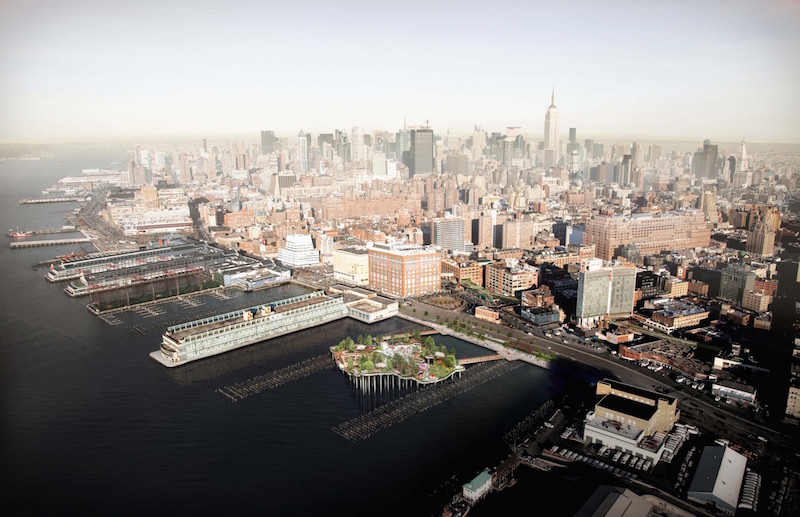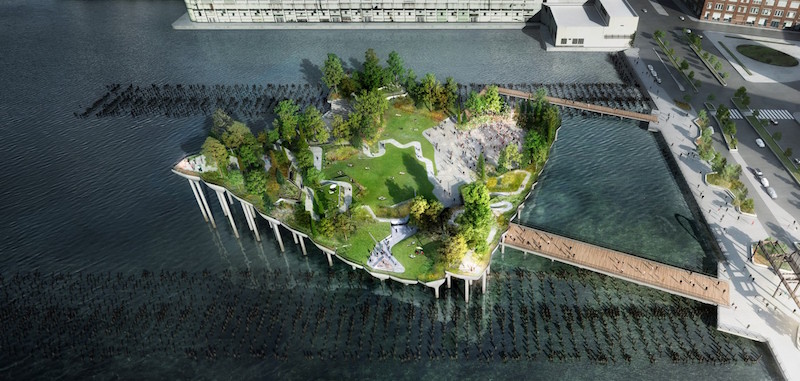Pier 55, a 2.7 acre park rising above the Hudson River on Manhattan’s lower west side, can move forward without hesitation as the New York Court of Appeals has denied City Club of New York’s motion for leave.
The park, whose construction is being privately funded by Diane Von Furstenberg and Barry Diller, has been embroiled in a legal battle almost from the moment of its conception.
The City Club brought forth the lawsuit arguing that just because the project is being privately funded, that doesn’t mean the basic rules of environmental review, public involvement, and the need for competitive bidding can be ignored. City Club also takes issue with the fact that the park will sit atop 550 piles and rise as high as seven stories above the water, fully obscuring a wide-open view of the Hudson.
City Club’s brief focused on the following issues:
- Failure to do an environmental impact statement
- Failure to study cumulative impacts of two related projects, Piers 55 and 57
- Failure to obtain competitive bids
- Failure to comply with legislation to allow reconstruction of Pier 54
- Failure to apply the public trust doctrine, particularly to ensure open public access
City Club says it got into the case because the project illustrates a city-is-for-sale mentality, is illegal under the terms of the Park Act, and bypassed environmental protection laws.
However, the most recent ruling from the Appellate Division may be the end of the lawsuit once and for all, as the Court of Appeals was one of the group’s final avenues for delaying the project, Curbed New York reports.
In a statement, Hudson River Park Trust President & CEO Madelyn Wils referred to the lawsuit as “ill-conceived” while expressing excitement over being able to continue construction on “one of the city’s most spectacular new public spaces.”
 Rendering courtesy of Heatherwick Studio
Rendering courtesy of Heatherwick Studio
 Rendering courtesy of Heatherwick Studio
Rendering courtesy of Heatherwick Studio
Related Stories
Urban Planning | Jul 13, 2016
'Shore to Core' competitions envision future waterfront cities
Design and research teams will use West Palm Beach, Fla., as their model.
Urban Planning | Jul 7, 2016
Y Combinator project would build new city using new technology, urban policies
Zoning, property rights, building codes all could be re-imagined.
Urban Planning | Jun 15, 2016
Swedish ‘Timber Town’ proposal from C.F. Møller provides a unique blend of nature and city
The development acts as a transition area between a traditional urban landscape and parklands.
Movers+Shapers | Jun 10, 2016
URBAN EVANGELIST: Bruce Katz sees America humming again, city by city
Katz, best known as Co-director of the Brookings Institution's Metropolitan Policy program, believes that cities are dynamic networks of like-minded public and private interests that have the potential to generate economic growth.
Urban Planning | Jun 9, 2016
Triptyque Architecture designs air-cleansing hanging highway garden in São Paulo
The garden would filter as much as 20% of CO2 emissions while also providing a place for cultural events and community activities.
Urban Planning | May 31, 2016
Vancouver park board approves final design for urban park
The green space is intended to be a recreation area for a busy part of downtown.
Urban Planning | May 31, 2016
The entire Swedish city of Kiruna is being relocated to prevent it from collapsing into underground iron mines
Kiruna, the northernmost city in Sweden, and its 20,000 residents will be moved two miles to the east by 2040.
Urban Planning | May 23, 2016
Developer acquires 62 acres of vacant land in Chicago
Related Midwest will turn the strip that connects the South Loop to Chinatown into a neighborhood with homes, stores, and offices.
Urban Planning | May 20, 2016
Why people are the most important factor in urban regeneration
What makes large-scale urban regeneration projects successful? CallisonRTKL's Edgar Kiviet explores how cities, particularly those in Eastern Europe, are undergoing a transformation.
Urban Planning | May 16, 2016
5 steps to creating high-performance communities
Perkins+Will's Noah Friedman and Kristen Hall break down the essential ingredients to create a neighborhood that's accessible, comfortable, and vibrant.

















